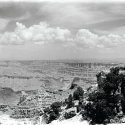THIS WORK IS BASED ON a single historical document: a slideshow made by commercial photographer Henry G. Peabody between 1899-1930 at the Grand Canyon of Arizona. The project reconstructs Peabody’s slideshow in a web-based medium, allowing readers to see beyond the photographer’s presentation of his forty-three individual image-objects. Enchanting the Desert, instead, uses the photographs to spatially narrate the cultural history of the Grand Canyon, laying bare the European American project of remaking this space, focusing on specific territories within the vast region where the subtle mechanics of colonization unfolded.
Viewers have for over a century visually swallowed whole the entirety of the details available to them in these pictures. With eyes agape, information has down-poured into the back recesses of our collective memory, where it carries out its duty of producing an expectation of what the Grand Canyon is, and what it looks like. But now it is time to temper that downpour, to move slowly through the slideshow, to look at its details with sympathetic, critical, giving, and analytic care, as it has never been seen before.
Doing so is not only reading the photographic objects to know the Grand Canyon, but is redefining the very way we come to know all landscapes that carry importance to us.
Readers of Enchanting the Desert encounter a pattern language that describes a new cultural becoming of this great landscape. Another layer on the palimpsest of meanings that have accrued here for nearly 10,000 years, the European American experience of the Grand Canyon is yet an altogether new one. Readers are given the opportunity to critically—and cartographically—evaluate how Peabody’s camera vision helped produce a national vision of the Grand Canyon, a vision that recast the space of the Grand Canyon in a new light.
Source: Enchanting the Desert | Home

